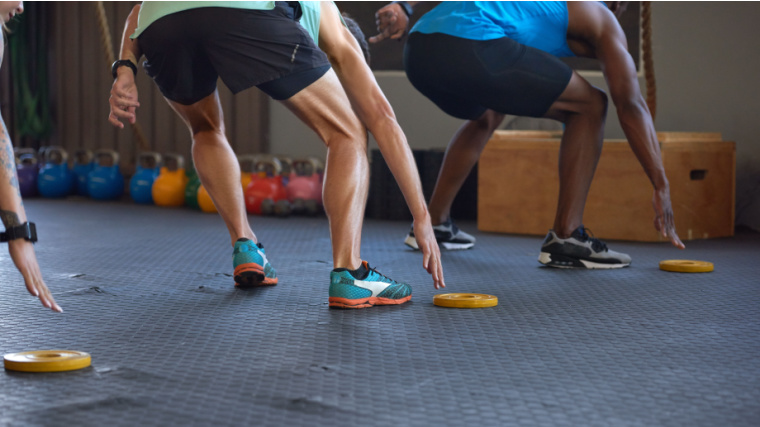[ad_1]
You don’t have to be working out deep inside a CrossFit box to be seduced by the proliferation of CrossFit-inspired shoes — the NOBULL Trainer and Nike Metcon come to mind. Sure enough, cross-trainers have been around since the 1980s and predate the mainstreaming of the sport of fitness.
For many casual athletes, there’s a running shoe and maybe a weightlifting shoe. After that point, your gym bag is way overloaded. But for those in search of more efficiency, who want to wear the same shoe to all parts of their training session, cross-trainers have a whole lot of appeal. You don’t only do one thing in the gym — why should your shoe?

But others remain skeptical that cross-training shoes make any difference at all. Often sold as the key to all manner of improvements in the gym, let’s find out if these shoes actually do make a difference. Here, we’ll dive in: What are cross-training shoes, and should you purchase a pair of your own?
What Are Cross-Training Shoes?
Legend has it that cross trainers were born when a Nike staffer saw pickup basketball players wearing running shoes on the court and spotted an obvious danger. (1) He identified that abrupt side-to-side movement could easily cause a fall or injury. Accordingly, he requested the creation of cross-trainers to offer greater lateral support for athletes than traditional running shoes. (1)
In subsequent advertisements, cross trainers were introduced as multipurpose athletic shoes that provided more heel support to reinforce multidirectional movements. (1) They lack the ankle extensions of basketball shoes.
[Read More: What Should You Look for in a Cross Training Shoe?]
Beyond these commonalities, cross-trainers have evolved to offer several different varieties and emphases. So, in today’s market, be selective about choosing the cross-trainers that best match your fitness goals and needs.
Who Should Use Cross-Training Shoes
Cross trainers are ideal shoes to protect your feet during everything from high-impact plyometric exercises to all-out sprint workouts.
[Read More: 6 Reasons You Should Invest In a Pair of Weightlifting Shoes]
That way, if your personal trainer suggests that you indulge in box jumps and burpees interspersed with traditional heavy deadlifts and overhead presses, your feet will remain supported the entire time. This also makes cross-trainers ideal for very specific groups of trainees.
CrossFitters
CrossFitters need to be prepared for all types of exercise — from rope climbs and double-unders to all-around heavy lifting — it’s ideal to own one shoe that can handle all those activities.
Modern cross trainers are often designed specifically with CrossFit in mind. This includes shoes equipped with additional rubber around the midsole to assist with rope climbs.

[Read More: The 5 Best Boxing Shoes You Can Buy]
“They are great for circuit or high-intensity interval training, allowing comfortable transitions from one movement to the next,” Bush explains. “Doing a CrossFit workout with varying movements, you need a shoe that can both be stable and flexible. Running shoes may help with jump rope and running, but hurt you on wall balls and cleans. Lifters would make the cleans and wall balls feel stable, but jumping and running would suck.”
Strength Athletes
Not all strength athletes consider weightlifting shoes to be the best shoes for weightlifting. Many prefer a pair of shoes with little arch support that encourages flat feet, and some even prefer to deadlift barefoot. Similarly, the question of cross-training shoes comes down to personal choice, even among lifters who engage in the most demanding forms of strength training.
[Read More: How to Find the Right Weightlifting Shoe Heel Height]
“Cross-trainers typically have a wide toe box, allowing the toes to spread to their natural shape establishing a solid foundation for lifting,” Bush says. “The rigid frame keeps the foot from moving too laterally in the shoe, which can lead to ankle injuries. Personally, my back squat, snatch, and clean & jerk PRs (personal records) are all in cross trainers.”
Non-Specialized Gymgoers
If you head to the gym without knowing precisely where your workout is going to take you, cross trainers are excellent shoes to be wearing. That way, if you decide to spontaneously fill your weekend with HIIT workouts, you won’t be caught wearing shoes that lack the shock absorption necessary to leap and a stable base to safely support multi-directional movements.
[Read More: How to Choose The Perfect Heel Height for Your Body and Squat Style]
“Most people who do not plan on specializing in any specific style of training would do well with a set of cross trainers,” Bush says. “Cross trainers are typically going to have a mostly flat sole with less padding throughout, and that gives them a grounded feel while lifting. The tradeoff is cross trainers don’t have the cushion to hide deficits in running form like a heel strike in the foot. The better your running form, the better a cross trainer shoe will feel.”
Cross-Training Shoes Vs. Lifting Shoes
Traditional weightlifting shoes are made with one purpose in mind: Competitive weightlifting. They have a heel wedge to stabilize your base as you’re lifting weights, and a midfoot strap positioned over the laces to grant you additional sturdiness. Cross trainers embolden their wearers to engage in a far greater variety of training.
[Read More: The Ultimate Cross Training and Lifting Shoe Size Guide]
“The Olympic lifting shoe is built for a highly specific purpose, with a rigid and lifted heel to aid in mobility and a rigid sole throughout the shoe to give the lifter the most stability possible,” Bush explains. “A cross-training shoe is typically going to incorporate the rigidity in the back of the heel and a flatter sole to give an athlete stability while lifting, then mix it with more flexibility throughout the midfoot and forefoot to allow for movements like running, box jumps, jump rope, and so on.”
Cross-Training Shoes Vs. Running Shoes
In terms of their structure, cross-training shoes have a lower heel-to-toe drop than running shoes and have more durable upper-foot materials. Beyond that, cross trainers often feature a wider rubber outsole, stretching the surface area that grips the ground. All of these features are intended to add support to lateral movements, allowing you to make your cardio workouts multidirectional.
“If you trade out your running shoes, throw on some cross-trainers, and head out for your normal running route, it is probably not going to feel great,” Bush explains. “Cross-trainers don’t have the cushion to hide deficits in running form like a heel strike in the foot, and over longer distances, the repeated impact will get uncomfortable or sometimes painful.”

[Read More: A Couch to 5K Training Plan for Strength Athletes of Different Experience Levels]
Distance generally makes a difference here, though. So if you’re not suiting up for a long run, cross-trainers might do just fine. “Most people in our gym are fine for distances up to a mile in cross-trainers,” Bush says. “Over that, most of them opt to change into running shoes.”
No Need to Work at Cross Purposes
Cross-trainers are designed to keep you stable and more secure during a wider variety of training types than either weightlifting shoes or running shoes. Because they take a “best of both worlds” approach, they’re not specialized for either weightlifting or running. So when you’re reaching elite levels of either sport, you might want to have a more specialized shoe in your gym bag.
That said, cross-trainers allow you to lift heavy and run short distances while also tackling multi-faceted training elements — all without changing your shoes. Cross-training shoes can give you a lot of bang for your buck since they’ll support multiple modalities at once. Especially if you’re just as likely to be performing box jumps as you are heavy deadlifts, cross-trainers may be just for you.
FAQs
If you have more questions about whether or not you actually need a pair of cross-trainers for your workouts, the answers below should point you in the right direction.
At their base level, cross-trainers are used to provide additional heel support to people during workouts and sporting events that require them to move in multiple directions. In theory, a gymgoer wearing cross trainers should be able to comfortably complete most strength training or CrossFit workouts, and even play a game of basketball or racquetball.
Most cross-trainer models are intended to comfortably accommodate runs of short to moderate distances, in addition to offering support for lateral movements and weight training workouts. But if you’re running over a mile, chances are you’ll be a lot more comfortable in a pair of shoes designed specifically for running.
The core benefits of the cross-training shoes include additional support for lateral movements and additional stability for weightlifting movements. Some of the best cross-training shoes also offer additional features, like extended rubber around the midsole for support during rope climbs.
References:
- Couzens, Gerald Secour. “A Shoe of All Trades.” Newsday [Hempstead/Long Island, New York]. 10 Mar. 1990, p. 39.
Featured Image: Ivanko80 / Shutterstock
[ad_2]
Source link


